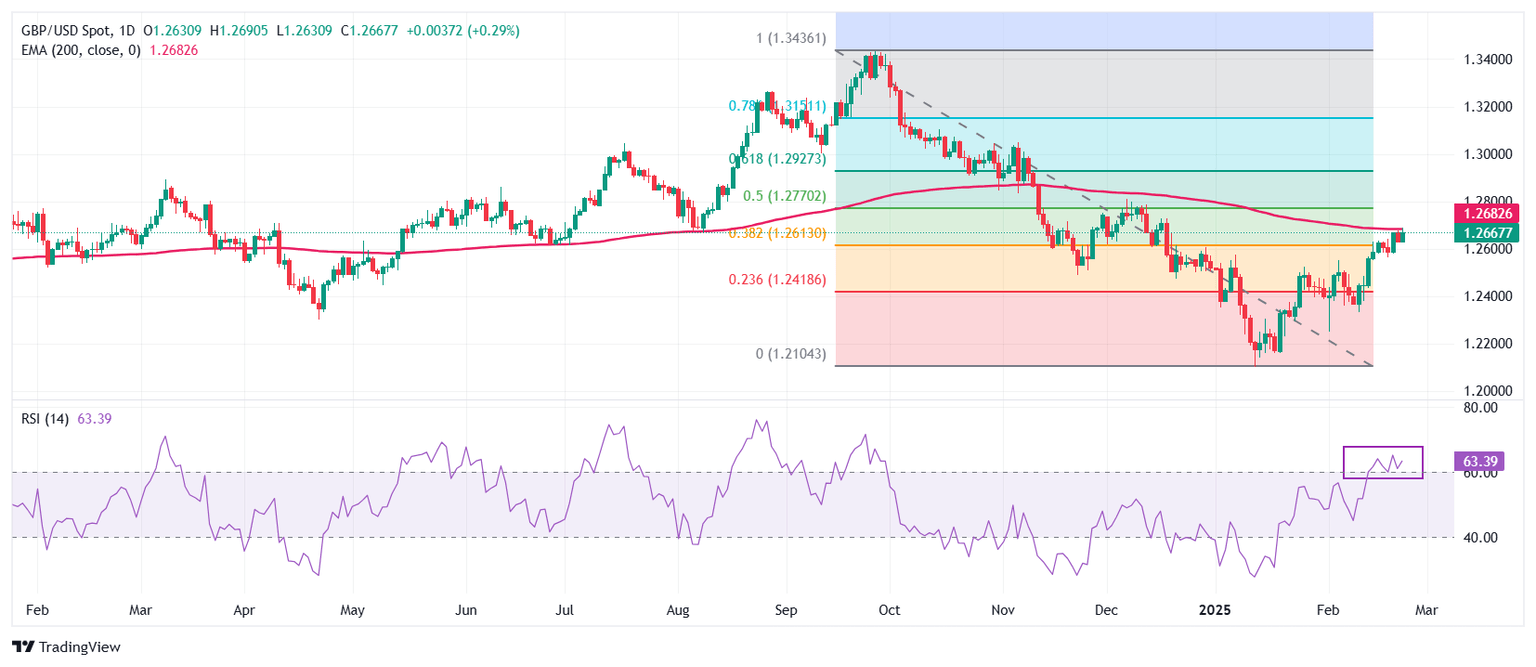Pound Sterling gains as BoE seems to follow slower monetary easing cycle
- The Pound Sterling moves higher as traders expect the BoE to cut interest rates two times more this year.
- US S&P Global Services PMI contracted for the first time in 25 months.
- This week, investors will focus on the US Durable Goods and PCE inflation data for January.

The Pound Sterling (GBP) gains against its peers as investors expect the Bank of England (BoE) to follow a moderate policy-easing cycle this year. Upbeat United Kingdom (UK) Retail Sales, hotter-than-expected Consumer Price Index (CPI) data for January, and strong wage growth momentum in three months ending December have forced traders to pare BoE dovish bets.
Traders expect the BoE to cut interest rates two more times this year, according to money market expectations. The BoE also reduced its key borrowing rates by 25 basis points (bps) to 4.5% in the policy meeting earlier this month.
Contrary to market expectations, analysts at TD Securities expect the BoE to cut interest rates four times more this year amid uncertainty over potential tariffs from a second Trump presidency. However, the agency has revised its forecast for the next interest rate cut to May from March due to recent stronger-than-expected UK economic data.
Going forward, speeches from BoE policymakers will influence the British currency. Clare Lombardelli, Swati Dhingra, and Deputy Governor Dave Ramsden are set to speak on Monday, and they could provide fresh cues about the monetary policy outlook.
On the economic data front, flash S&P Global/CIPS PMI data for February has come in line with estimates. The Composite PMI expanded at a slower pace to 50.5 from 50.6 in January. Activities in the manufacturing and services sectors contracted and expanded, respectively, at a surprisingly faster pace.
Daily digest market movers: Pound Sterling surrenders some gains against USD
- The Pound Sterling surrenders some of its intraday gains after facing resistance near 1.2700 against the US Dollar (USD) in North American trading hours on Monday. The GBP/USD pair falls from the intraday high as the US Dollar bounces back. The US Dollar Index (DXY), which tracks the Greenback’s value against six major currencies, recovers to near 106.50 after sliding to near the 12-week low of 106.10.
- Earlier in the day, the US Dollar fell sharply due to weak United States (US) services sector activity data, which increased bets for an interest rate cut by the Federal Reserve (Fed) in June. The US Dollar Index (DXY), which tracks the Greenback’s value against six major currencies, declines to near 106.10, the lowest level in almost 12 weeks.
- On Friday, the US preliminary S&P Global Purchasing Managers Index (PMI) report showed a significant slowdown in business activity in February. The Composite PMI rose at a slower pace to 50.4 from 52.7 in January as activities in the services sector declined unexpectedly. The Services PMI contracted to 49.7 from 52.9, falling below the 50 threshold for the first time in 25 months. Economists expected the service sector activity to have expanded at a slightly faster pace to 53.0.
- Service providers commonly linked the downturn in activity and worsening new orders growth to political uncertainty, notably in relation to federal spending cuts and potential policy impacts on economic growth and inflation outlooks, according to the S&P Global PMI report.
- According to the CME FedWatch tool, the probability of the Fed’s interest rates remaining unchanged at the current range of 4.25%- 4.50% is 41.1%, down from nearly 50% before the PMI release.
- On the contrary, the Manufacturing PMI expanded faster than expected to 51.6 in February from estimates of 51.5 and the former reading of 51.2.
- The business activity data indicates the positive impact of US President Donald Trump’s tariff agenda on the country’s manufacturing sector. Trump had already mentioned in his comments that tariffs on imports would boost production activities locally, fulfilling his agenda of making “America great again”.
- This week, investors will focus on the US Durable Goods Orders and the Personal Consumption Expenditures Price Index (PCE) data for January, which will be released on Thursday and Friday, respectively.
Technical Analysis: Pound Sterling recovery stalls near 200-day EMA
The Pound Sterling struggles to extend its upside to near the 200-day Exponential Moving Average (EMA), which stands around 1.2680, against the US Dollar in Monday’s North American session. The GBP/USD pair strengthened after breaking above the 38.2% Fibonacci retracement from the end-September high to the mid-January low downtrend around 1.2620.
The 14-day Relative Strength Index (RSI) holds above 60.00. The bullish momentum would strengthen if the RSI (14) sustains above that level.
Looking down, the February 11 low of 1.2333 will act as a key support zone for the pair. On the upside, the 50% and 61.8% Fibonacci retracement at 1.2770 and 1.2927, respectively, will act as key resistance zones.
BoE FAQs
The Bank of England (BoE) decides monetary policy for the United Kingdom. Its primary goal is to achieve ‘price stability’, or a steady inflation rate of 2%. Its tool for achieving this is via the adjustment of base lending rates. The BoE sets the rate at which it lends to commercial banks and banks lend to each other, determining the level of interest rates in the economy overall. This also impacts the value of the Pound Sterling (GBP).
When inflation is above the Bank of England’s target it responds by raising interest rates, making it more expensive for people and businesses to access credit. This is positive for the Pound Sterling because higher interest rates make the UK a more attractive place for global investors to park their money. When inflation falls below target, it is a sign economic growth is slowing, and the BoE will consider lowering interest rates to cheapen credit in the hope businesses will borrow to invest in growth-generating projects – a negative for the Pound Sterling.
In extreme situations, the Bank of England can enact a policy called Quantitative Easing (QE). QE is the process by which the BoE substantially increases the flow of credit in a stuck financial system. QE is a last resort policy when lowering interest rates will not achieve the necessary result. The process of QE involves the BoE printing money to buy assets – usually government or AAA-rated corporate bonds – from banks and other financial institutions. QE usually results in a weaker Pound Sterling.
Quantitative tightening (QT) is the reverse of QE, enacted when the economy is strengthening and inflation starts rising. Whilst in QE the Bank of England (BoE) purchases government and corporate bonds from financial institutions to encourage them to lend; in QT, the BoE stops buying more bonds, and stops reinvesting the principal maturing on the bonds it already holds. It is usually positive for the Pound Sterling.
Author

Sagar Dua
FXStreet
Sagar Dua is associated with the financial markets from his college days. Along with pursuing post-graduation in Commerce in 2014, he started his markets training with chart analysis.


















